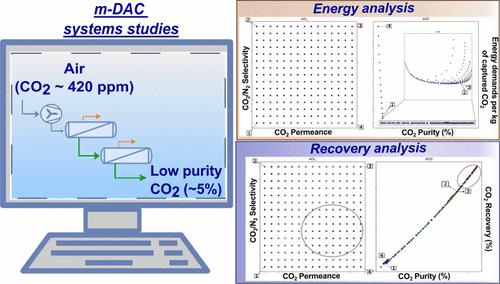基于膜的低纯度二氧化碳生产直接空气捕集工艺可操作性分析
IF 4.3
Q2 ENGINEERING, CHEMICAL
引用次数: 0
摘要
应对气候变化是本世纪面临的重大科学挑战之一,人们普遍认为人为二氧化碳排放在很大程度上造成了这一问题。为了实现 "净零排放 "目标,并将全球平均气温升幅控制在 1.5 ℃ 以下,必须大规模开发和部署负排放技术。本研究调查了使用膜作为直接空气捕获(DAC)技术从大气中提取二氧化碳生产低纯度二氧化碳的可行性。在这项工作中,使用 AVEVA 过程模拟平台设计并模拟了一个两级中空纤维膜组件过程,以生产低纯度(≈5%)二氧化碳渗透流。这种低纯度二氧化碳流可能有多种用途,如藻类生长、催化氧化和提高石油采收率。通过将可行的输入参数范围(包括膜表面积和膜性能指标)映射到输出集(包括二氧化碳纯度、回收率和净能耗),进行了可操作性分析。在 DAC 条件下测试时,考虑到具有高 CO2/N2 分离性能(CO2 渗透率 = 2100 GPU 和 CO2/N2 选择性 = 1100)的促进传输膜,生成了本模拟研究的基本案例。在膜面积不变的情况下,两种膜的内在性能对纯度、回收率和能耗都有相当大的影响。第一膜组件的面积在决定回收率、纯度和能源需求方面起着主导作用,事实上,增加第二膜组件的面积会对总体能源消耗产生负面影响,而不会提高总体纯度。DAC 装置的二氧化碳捕集能力对于实施和扩大规模非常重要。在这种情况下,所进行的分析表明,m-DAC 工艺适合作为小容量系统(0.1-1 百万吨/年空气),具有合理的回收率和整体纯度。最后,对基于膜的 DAC 工艺进行了初步的二氧化碳排放分析,得出的结论是,整个能源网必须由可再生能源供电,该技术才符合负排放类别的要求。本文章由计算机程序翻译,如有差异,请以英文原文为准。

Process Operability Analysis of Membrane-Based Direct Air Capture for Low-Purity CO2 Production
Addressing climate change constitutes one of the major scientific challenges of this century, and it is widely acknowledged that anthropogenic CO2 emissions largely contribute to this issue. To achieve the “net-zero” target and keep the rise in global average temperature below 1.5 °C, negative emission technologies must be developed and deployed at a large scale. This study investigates the feasibility of using membranes as direct air capture (DAC) technology to extract CO2 from atmospheric air to produce low-purity CO2. In this work, a two-stage hollow fiber membrane module process is designed and modeled using the AVEVA Process Simulation platform to produce a low-purity (≈5%) CO2 permeate stream. Such low-purity CO2 streams could have several possible applications such as algae growth, catalytic oxidation, and enhanced oil recovery. An operability analysis is performed by mapping a feasible range of input parameters, which include membrane surface area and membrane performance metrics, to an output set, which consists of CO2 purity, recovery, and net energy consumption. The base case for this simulation study is generated considering a facilitated transport membrane with high CO2/N2 separation performance (CO2 permeance = 2100 GPU and CO2/N2 selectivity = 1100), when tested under DAC conditions. With a constant membrane area, both membranes’ intrinsic performances are found to have a considerable impact on the purity, recovery, and energy consumption. The area of the first module plays a dominant role in determining the recovery, purity, and energy demands, and in fact, increasing the area of the second membrane has a negative impact on the overall energy consumption, without improving the overall purities. The CO2 capture capacity of DAC units is important for implementation and scale-up. In this context, the performed analysis showed that the m-DAC process could be appropriate as a small-capacity system (0.1–1 Mt/year of air), with reasonable recoveries and overall purity. Finally, a preliminary CO2 emissions analysis is carried out for the membrane-based DAC process, which leads to the conclusion that the overall energy grid must be powered by renewable sources for the technology to qualify within the negative emissions category.
求助全文
通过发布文献求助,成功后即可免费获取论文全文。
去求助
来源期刊

ACS Engineering Au
化学工程技术-
自引率
0.00%
发文量
0
期刊介绍:
)ACS Engineering Au is an open access journal that reports significant advances in chemical engineering applied chemistry and energy covering fundamentals processes and products. The journal's broad scope includes experimental theoretical mathematical computational chemical and physical research from academic and industrial settings. Short letters comprehensive articles reviews and perspectives are welcome on topics that include:Fundamental research in such areas as thermodynamics transport phenomena (flow mixing mass & heat transfer) chemical reaction kinetics and engineering catalysis separations interfacial phenomena and materialsProcess design development and intensification (e.g. process technologies for chemicals and materials synthesis and design methods process intensification multiphase reactors scale-up systems analysis process control data correlation schemes modeling machine learning Artificial Intelligence)Product research and development involving chemical and engineering aspects (e.g. catalysts plastics elastomers fibers adhesives coatings paper membranes lubricants ceramics aerosols fluidic devices intensified process equipment)Energy and fuels (e.g. pre-treatment processing and utilization of renewable energy resources; processing and utilization of fuels; properties and structure or molecular composition of both raw fuels and refined products; fuel cells hydrogen batteries; photochemical fuel and energy production; decarbonization; electrification; microwave; cavitation)Measurement techniques computational models and data on thermo-physical thermodynamic and transport properties of materials and phase equilibrium behaviorNew methods models and tools (e.g. real-time data analytics multi-scale models physics informed machine learning models machine learning enhanced physics-based models soft sensors high-performance computing)
 求助内容:
求助内容: 应助结果提醒方式:
应助结果提醒方式:


